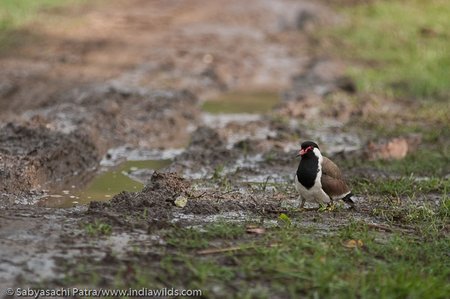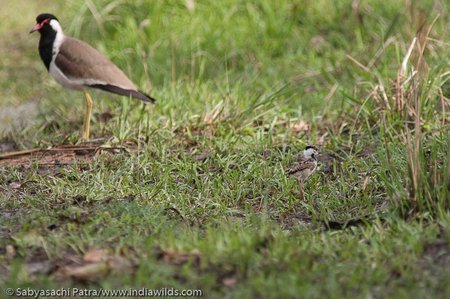Ethics in Nature Photography
Today I am recalling an incident that had a huge impact on me and that shaped my views on Ethics in Nature and wildlife photography.
It was a cold morning in Corbett Tiger Reserve, India. It had rained in the night, and there were mud puddles everywhere. We started in the morning and despite a fresh smell of tiger scent spray, we could not sight a tiger or for that matter any carnivore. I knew that it was a missed chance, and there was no way we can find the tiger in such weather. We were on a dirt road that had once connected a small village. The village has been relocated and since then nature has taken over and has converted the empty space into a lovely grassland.
Extended stretches of the dirt road had stagnant or flowing water over it and it was really slippery. We soon reached a spot, where a couple of Red Wattled lapwings were present by the road side. We stopped the vehicle to watch the lapwings. Suddenly I could see that the two chicks emerge out of the feathers of a lapwing. It was interesting watching how beautifully the lapwing had hidden her two small chicks between her feathers. She slowly started moving away from the road.
One of the chicks followed her and the other moved in another direction. I was photographing the mother and chicks from a distance. We watched them for some time and then moved ahead in search of the apex predator.

We spent about two hours waiting to hear alarm calls. Unfortunately, there were no animal movements and we returned back. This time, the lapwing and the chicks were on the dirt track. As is their nature, the two adult lapwings moved in different directions to divert attention. One of the chicks ran away, whereas the other didn’t. It simply froze on the ground. We moved the vehicle slightly closer and the camouflage was so good, I took some time to find out where it was.

I moved closer to take a couple of shots of the excellent camouflaging. I was wondering about the composition, since the steep angle was not to my liking. I naturally didn’t want to get down to the ground level for the fear of disturbing the chick which was already trying to hide itself by virtue of its camouflaging. At that moment, a black ant started climbing over the chick.

It climbed on its beak and then moved towards its eyes. The left eye of the chick was open to keep a watch on us. The black ant then climbed onto the eye of the chick. The chick closed its eye very slowly.

I am not sure whether the black ant was biting the chicks eye. At least the chick must be feeling irritation in the eye.
I felt that due to fear of detection the lapwing chick closed its eye very slowly, and probably when it would have hurt. I was horrified.
I immediately asked the driver to drive on. Though I got an insight into its behaviour, I was certainly disturbed. Due to a human presence, the chick is slowly closing its eye, and is perhaps risking eye damage by not closing it, because it felt the danger of detection by a man is far greater.
I kept on brooding over the scene. I felt extremely bad, that apart from increasing the adrenalin flow in the little chick, I was perhaps unknowingly causing it potential eye damage. �I felt so bad, that I never shared this images with anyone till date. Finally, I decided to publish this incident and photographs for the sake of spreading the message. Ethics in photography is neither taught in photography courses nor do photographers care about it. And wildlife photographers as a smaller subset of people practicing are perhaps among the worst of the lot.�I don’t find wildlife photographers caring about ethics.
Often researchers engage in photographing and observing nests. The question one has to answer is whether the image or knowledge acquired in the process is greater than the welfare of the subject?
If you are near a human habitation and photographing or filming the same scene, there is a danger of crows and other birds following you and catching the chick. I think if that happens, then you can’t just wash off your hands by saying that it is survival of the fittest. I would say if that happens, then you may not have killed the chick, but you are an accomplice in the crime.
I had never before put any animal in danger due to my photography. And now, without any intention, there is a potential harm to the chick. Even till date it saddens me. I never shared that image with others. Today, I thought of writing this to tell the photographers – at the risk of getting lot of flak from them – that we can cause harm unintentionally, so it is better to avoid photographing chicks in nests.
In India, there is no rule about photographing birds in nests. Ofcourse there is a group of photographers, who are never concerned about the welfare of the subject. There is another group of photographers, who don’t allow sharing of nesting photographs in photosharing sites, but do nothing to save wilderness areas or wildlife. Infact, they actively discourage conservation.
Royal Photographic Society Guidelines on Ethics in Photography:
In UK they have a well defined system of issuing licenses for photographing a few endangered species. I thought of digging out some of the best practices. The do’s and don’ts mentioned in the Royal Photographic Society is a good starting point. I have adapted some of those for us.
I quoting some relevant extracts from it:
Photography should not be undertaken if it puts the subject at risk. Risk to the subject, in this context, means risk of disturbance, physical damage, causing anxiety, consequential predation, and lessened reproductive success.
- Apparent lax or absence of local legislation should not lead any photographer to relax his/her own high standard.
- The photographer should be familiar with the natural history of the subject; the more complex the life-form and the rarer the species, the greater his/ her knowledge must be. He/ she should also be sufficiently familiar with other natural history subjects to be able to avoid damaging their interests accidentally. Photography of uncommon creatures and plants by people who know nothing of the hazards to species and habitat is to be deplored.
- Photographs of dead, stuffed, homebred, captive, cultivated, or otherwise controlled specimens may be of genuine value but should never be passed off as wild and free. Users of such photographs (irrespective of the purpose for which it is thought they will be used) should always be informed, regardless of how little they may seem to care.
- Photography of birds at the nest should only be undertaken by those with a good knowledge of bird breeding behaviour. There are many competent photographers (and bird watchers) who lack this qualification.
- A hide should always be used if there is a reasonable doubt that birds would continue normal breeding behaviour otherwise. No part of the occupant should be visible from the outside of the hide.
- Reported nest failures due to nest photography are few, but a high proportion of those that occur are due to undue haste. The maximum possible time should elapse between stages of hide movement or erection, introduction of lens or flash equipment, gardening and occupation. Many species need preparation at least a week in advance; this should be seen as the norm. Each stage should be fully accepted by the bird (or birds, where feeding or incubation is shared) before the next stage is initiated. If a stage is refused by the birds (which should be evident from their behaviour to a competent bird photographer) the procedure should be reversed at least one stage; if refusal is repeated photography should be abandoned.
Unfortunately, though photographers often agree that they should not put the subject at risk, the way they define it is often to their benefit and the subject is often harmed.
Ethics in photography is often debated because photographers often don’t understand the impact of their actions on wild species and wilderness areas. Photographers often move close to birds and they have to abandon their eggs for a brief period. This results in a big drop in temperature. Often that is the difference between life and death. So ethics in wildlife photography can be improved if awareness about the species and wilderness places is created.
I am inviting suggestions from all on this issue of Ethics in Photography. I think we should develop a code of conduct, as there is none in India. You can post your views about Ethics in Nature Photography in the comments below.
- Canon Launches Cine Servo 11-55 mm T2.95-3.95 lens - 10 September,2025
- Water Monitor Lizard in Sundarbans - 14 May,2025
- Radio collared Tigress - 30 January,2025




Hi,
I genuinely loved this brilliant article. Please continue this awesome work. Thanks…
Thank you for this piece, which I only saw just now. I laud your contribution to raising the standards of ethical photography in India.
Dear Bittu,
Thanks a lot for your kind words. I have been trying to do my bit in raising awareness, hoping that wildlife photographers will stop harming the species they are photographing. However, we have to get more and more people to disapprove and perhaps censure the action of unethical photographers.
Sabyasachi